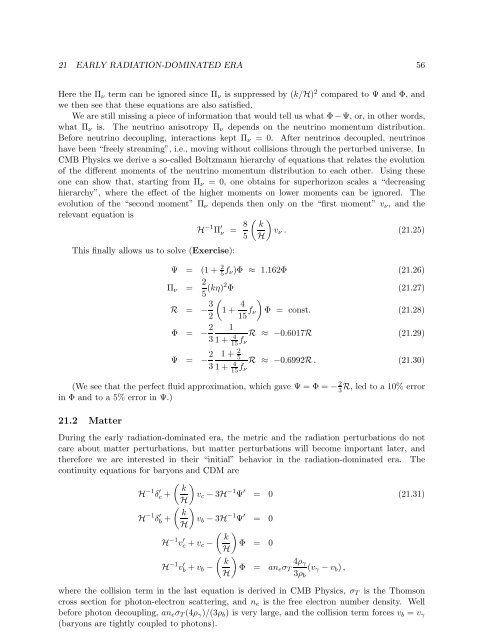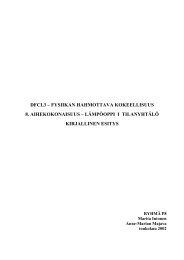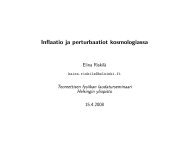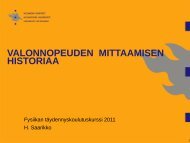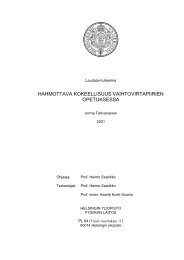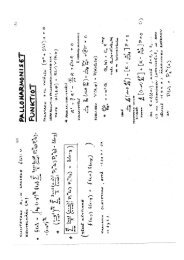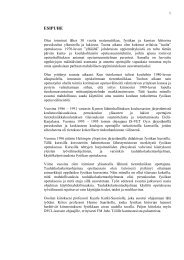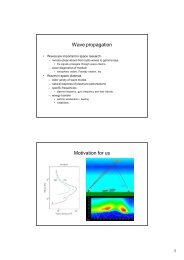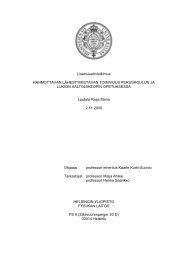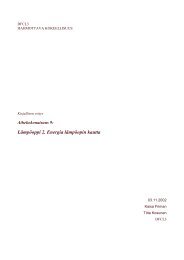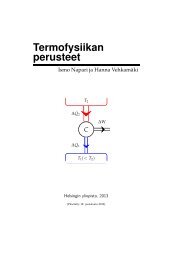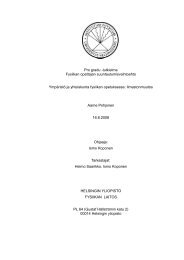Cosmological Perturbation Theory, 26.4.2011 version
Cosmological Perturbation Theory, 26.4.2011 version
Cosmological Perturbation Theory, 26.4.2011 version
You also want an ePaper? Increase the reach of your titles
YUMPU automatically turns print PDFs into web optimized ePapers that Google loves.
21 EARLY RADIATION-DOMINATED ERA 56Here the Π ν term can be ignored since Π ν is suppressed by (k/H) 2 compared to Ψ and Φ, andwe then see that these equations are also satisfied.We are still missing a piece of information that would tell us what Φ −Ψ, or, in other words,what Π ν is. The neutrino anisotropy Π ν depends on the neutrino momentum distribution.Before neutrino decoupling, interactions kept Π ν = 0. After neutrinos decoupled, neutrinoshave been “freely streaming”, i.e., moving without collisions through the perturbed universe. InCMB Physics we derive a so-called Boltzmann hierarchy of equations that relates the evolutionof the different moments of the neutrino momentum distribution to each other. Using theseone can show that, starting from Π ν = 0, one obtains for superhorizon scales a “decreasinghierarchy”, where the effect of the higher moments on lower moments can be ignored. Theevolution of the “second moment” Π ν depends then only on the “first moment” v ν , and therelevant equation isH −1 Π ′ ν = 8 ( kv ν . (21.25)5 H)This finally allows us to solve (Exercise):Ψ = (1 + 2 5 f ν)Φ ≈ 1.162Φ (21.26)Π ν = 2 5 (kη)2 Φ (21.27)R = − 3 (1 + 4 )2 15 f ν Φ = const. (21.28)Φ = − 2 13 1 + 415 f R ≈ −0.6017Rν(21.29)Ψ = − 2 1 + 2 53 1 + 415 f R ≈ −0.6992R.ν(21.30)(We see that the perfect fluid approximation, which gave Ψ = Φ = − 2 3R, led to a 10% errorin Φ and to a 5% error in Ψ.)21.2 MatterDuring the early radiation-dominated era, the metric and the radiation perturbations do notcare about matter perturbations, but matter perturbations will become important later, andtherefore we are interested in their “initial” behavior in the radiation-dominated era. Thecontinuity equations for baryons and CDM are( ) kH −1 δ c ′ + v c − 3H −1 Ψ ′ = 0 (21.31)H( ) kH −1 δ b ′ + v b − 3H −1 Ψ ′ = 0H( kH −1 v c ′ + v c − Φ = 0H)( kH −1 v b ′ + v 4ρ γb − Φ = an e σ T (v γ − v b ),H)3ρ bwhere the collision term in the last equation is derived in CMB Physics, σ T is the Thomsoncross section for photon-electron scattering, and n e is the free electron number density. Wellbefore photon decoupling, an e σ T (4ρ γ )/(3ρ b ) is very large, and the collision term forces v b = v γ(baryons are tightly coupled to photons).


